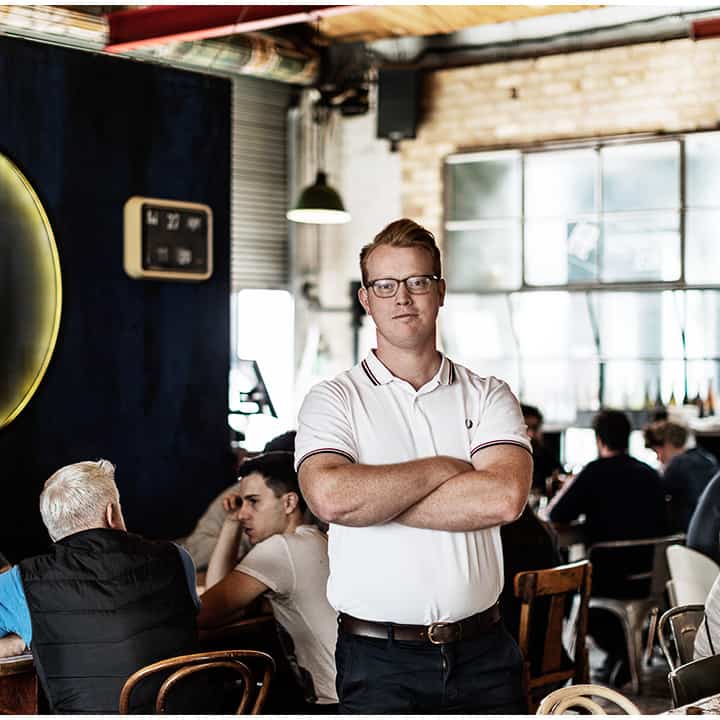
“One of the key things for me and most successful business operators is to understand how reporting functionality can help you track the progress of your business.”
Nigel Coffee founder, Dan Dick definitely has the magic touch, and he’s no stranger to the coffee industry, either. Dan was one of the original co-founders of the ever-popular Age Of Sail Coffee Brewers and most recently has been serving as the International Wholesale Manager for ST ALi Coffee Roasters.
Nigel opened their doors in early 2019 to coffee lovers in the Melbourne suburb of Camberwell, ticking all the boxes when it comes to a quality cup-o-joe, unique and delicious offerings, great vibes, and service with a smile. The atmosphere is warm, friendly, inviting, and the team serves up mouth-watering treats that are actually baked on site by Dan’s wife. It’s clear to see how guys are already tipping the scales on (homemade) brownie points as far as neighbourhood coffee shops are concerned, and they’ve only just begun.
We caught up with Dan to talk all about his sassy brand, and how it came to life, you can tuck into all of that goodness here. But, as we all know, behind every successful brand, there are tools and processes in place to keep everything running smoothly, and evolving with the rest of the world. So, we explored how Dan and his team are using Lightspeed to do just that.
Can you describe your Lightspeed set up?
We do counter service. The space is only 35 square meters so people come in the door, they walk up to whoever is standing at the till, and they place their order. Then, we move onto the next person. We do have other capabilities for doing table service, but it’s not the core of what our business is. I just start tabs, and I’ve got accounts running for a number of the small businesses around us. That’s more or less how we interact with customers. We just recently integrated our Westpac Presto payment terminal with the POS which has been really fantastic.’ We just recently had the integrated system with Westpac added which has been really fantastic. You don’t have to rely on manually entering importing transaction values into an EFTPOS terminal, moving it around as you interact with it, and handing it to your customer. We can literally put our transaction into our point of sale system, hit a button, and that value comes up on the terminal that’s frontward facing to the customer. It’s really clean, and a simple way to transact.
What is it about Lightspeed that makes you want to keep using us?
I think I’d just emphasise that the people have been really helpful. The Lightspeed guys are people in the industry that I’ve always had a massive amount of respect for.
What about in the weeks leading up to the launch? Was there anything about the account set up on the support side that really stood out to you?
Just the availability of the service, really. But at the end of the day, I found one of the other benefits to the product was that when I actually sat down to set it up, I was more or less able to do it myself. All that I needed from the support team were slight changes to things like reporting and functionality – just a way that I could manage some of the categories to make sure I could see them at the touch of a button.
The availability of support and service really stood out, but also just how easy the system was to set up. I think one of the failures, particularly of technical products developed by software engineers, is that they don’t think the way people like me do.
From a business person’s perspective, the functionality is super important, but also the way things occur when you’re putting in something like a coffee order, and then the way that translates to how the docket is printed. In a venue like mine where you’re hopefully printing hundreds of dockets every couple of hours, it’s important that the baristas can see exactly what they need to make in a clear and logical way. In the same way you put that information through the POS terminal, it needs to be really easy for me to go in from one prompt to the next, whether that be the size of a coffee, the variety of coffee, modifications to orders, or switching over to another product like tea. The system also makes it very easy to make changes if you’ve done something wrong in the back office, like modifying prices or adding discounts.
If you were to recommend Lightspeed to a friend, how would you describe it and what it can do for them?
It’s user-friendly, it’s easy to get the key things out of it that you want, it’s got great support, and it’s cost-effective.
Can you explain what you mean by “easy to get the key things”?
One of the key things for me and most successful business operators is to understand how the reporting functionality can help you track the progress of your business. I’ve used other systems where it’s actually really difficult to get things like a count on coffee, or a count on products sold, or even to do things like manipulate the way you assign tax to certain products. For example, a lot of people don’t know that when they sell retail coffee, they don’t have to charge GST on it. So, if they go with the blanket approach of how tax is applied in their pricing structure, they later realise they don’t know how to make the appropriate amendment. With Lightspeed, stuff like this is all very intuitive and relatively straightforward.

What do you think the biggest risks to your business would have been if you had used a different system?
As I said, the setup costs on some of the others are just astronomical. If it’s not going to be reliable, then it becomes a pretty bitter pill to swallow. Everyone is trying to set businesses up as cost-effectively as possible without skimping on the edges. You need to be able to make sure that you’re not only spending your money wisely, but also getting the best return on investment.
For example, I rely so heavily on how quickly I can move through orders because I’m doing counter service in a really high-density space. Everyone comes to one point of sale to order their coffee, so between 9:00 am and 10:30 am, we can do over 120 transactions. Making sure our system is reliable and quick has become really important for us. Using a system that’s slow, lagging, or prone to freezing would have really risked things for me. Once you’ve gone with one system, it’s really hard to change.
Before you integrated your Westpac terminal, how were you handling Credit card payments?
We had a terminal and we processed things manually by ourselves, which is slow and cumbersome. It opens the opportunity for human error which no one likes. Terminal integration basically guarantees you’re charging the right price, and I think that’s really important because you never want to hit an extra zero or leave one out. Then your till doesn’t balance and you spend hours pulling your hair out while trying to figure out what went wrong. It’s nice to have a level of assurance behind the way you take transactions from customers.
If you were to recommend Integrated Payments to a friend, how would you describe what it can do for them?
It’s quick and easy. From the customer perspective, it’s helpful that you’re not moving from processing the order, to grabbing an EFTPOS terminal, then importing the numbers. It’s just clunky, whereas when you’re only dealing with one piece of technology and the terminal is in a position that’s convenient for the customer, it’s more seamless and provides a better level of service. That’s important.

What are the top three benefits of having integrated payments?
Lack of Human error, and precise integration. The other thing I love about it is that you don’t have to print little paper dockets anymore. Do you know how much paper you waste with the old system? I’d spend time tearing them off, then throwing them in the bin. You’re meant to store them for four years, so you’re just collecting all this garbage that no one is going to want. I hated it, and I’m so glad I don’t have to do it anymore.
What about reconciliation?
It’s the same thing – you hit one button at the end of the day and you see everything on one page, so your report is all in one place. It’s easy. You don’t have to clip an EFTPOS reconciliation to your till roll at the end of the day, either. That’s always handy as well.
Are you able to quantify any of these benefits, like how much time it saves your team?
I would say it saves probably about 5 seconds per customer, so it depends on how many customers you have.
Are you able to give us an estimate of the additional revenue it might be bringing in?
The system makes it really easy to pay by card, so people can’t use lack of cash as a deterrent for payment, particularly if they’re paying with a card on their phone. I had a guy came in today and he used some sort of fancy ring as a card payment. I’d say maybe $500 a week.
Imagine in two years, you’ve opened three more sites and tripled your staff count, what do you think will be the biggest benefit of Integrated Payments at this future stage of your business?
The more venues you’ve got, the more risk you have of error, particularly if you’re not able to physically be present in all of them at the same time. So, I think the benefit is that you get the same level of assurance across each venue. There’s nothing worse than having a till that doesn’t balance, you know?

Can you elaborate on that last point about having a till that doesn’t balance? Why is that frustrating?
Because it either means that you haven’t accounted for the number of sales you’ve done and you’ve put money in the till without the order going through. Or, you’ve miscounted money or undercharged people. As I said, if you miss a zero and you charge people a buck instead of ten, then suddenly your till is down nine dollars and you don’t know why.
When sifting through transaction history, it’s really helpful to know that at least one step in the process is confirmed to be the same. If you put the order in right, then you’ll charge the right amount. And that’s just in one venue. Across three, there should be less flex in the numbers you have at the end of each day, week, year.
How have you found training new staff to use Lightspeed?
It’s super logical, so as long as they’ve got a basic fundamental understanding of how Point of Sale works, it’s very easy for them to pick it up. That’s more or less it. As I’ve said, it’s intuitive, it’s logical, and it’s very easy for people to use it because it prompts them into all of the steps needed to make sure that the right menu item is being put in, and that the right money is being processed and transacted.

News you care about. Tips you can use.
Everything your business needs to grow, delivered straight to your inbox.



